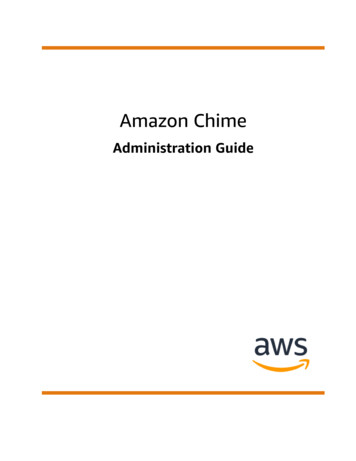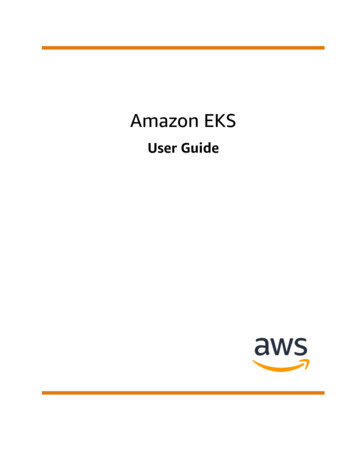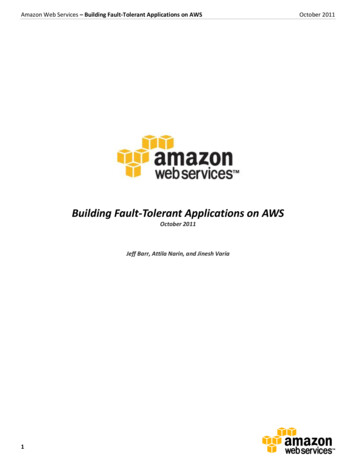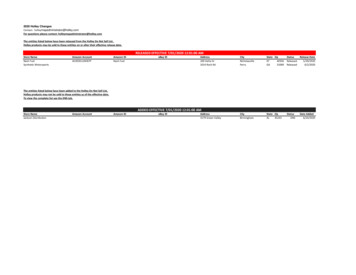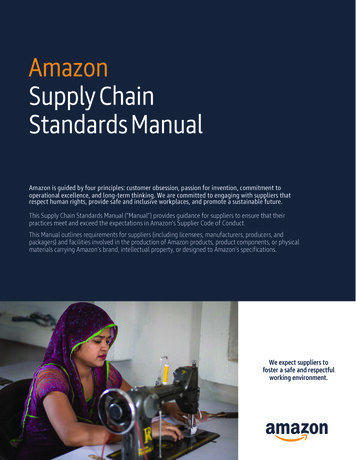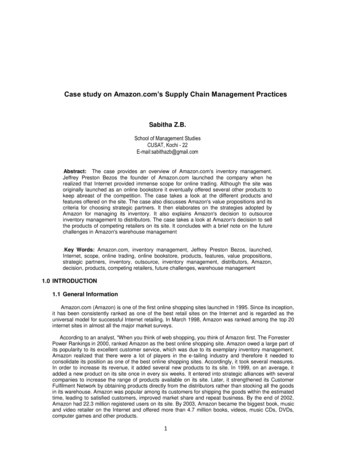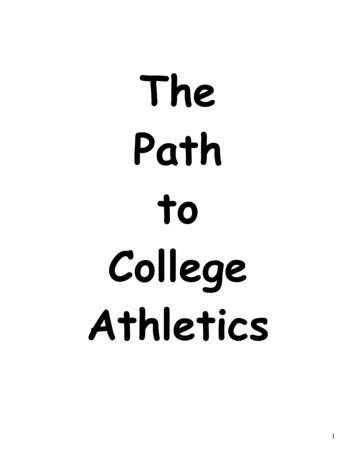
Transcription
1
Table of ContentsI.Your High School PlanII.NCAA Regulations and RequirementsIII.Your Grade Point AverageIV.SAT and ACT DatesV.Questions about Academic RequirementsVI.Differences between Divisions I, II, &IIIVII.Recruiting RegulationsVIII.Questions for Your School CounselorIX.Explanations/Questions about FinancialAidX.Helpful Websites2
3
HIGH SCHOOL SCHEDULEFreshman Sophomore Junior SeniorFRESHMAN YEAR: Get settled in high school.Concentrate on a solid high school curriculum.YOU MUST HAVE A STRONG CORE GPA TO GET INTO COLLEGE AND IT STARTSNOW.SOPHOMORE: Continue striving for academic success.Research NCAA academic requirements.Sign up for SAT/PSAT- given in OctoberMake sure that you are "on target" for all course requirements.During summer between Sophomore and Junior years prepare your athletic resume.Start investigating colleges and their admission requirements.Prepare to send out your initial contact letters.JUNIOR: Send out athletic letters now, if you have not already done so.Request the SAT/ACT test scores be sent to the NCAA Initial Eligibility Clearinghouse.Now is the time for you to join the clearinghouse.KEEP UP WITH STUDIES and once again review the NCAA requirements.Send out updates as your season closes.SENIOR: Do not let up on academics.Review your core class requirements with your counselor.Again, send out your team schedule as soon as possible to all schools you are interested in.Always play to the best of your ability, and remember you're a "student athlete".S t u d e n t C o m e s F i r s t.ACADEMICS BEFORE ATHLETICS!!!!!4
ACTION PLAN: HIGH SCHOOLFRESHMENFallPlan for the Year Ahead Meet with your counselor to discuss your college plans. Review your schedule withhim or her to make sure you're enrolled in challenging classes that will help youprepare for college. Colleges prefer four years of English, history, math, science, anda foreign language. Use College Search to find out the required courses and tests of colleges that youmight be interested in attending. Start a calendar with important dates and deadlines. Get more involved with your extracurricular activities. Go to college fairs in your area.WinterLearn about Colleges Learn about college costs and how financial aid works.Use the College Savings Calculator to see how much money you'll need for college,whether you're on track to save enough, and what you need to do to reach your goal.Talk to your parents about financing college.Visit colleges while they're in session.Find out about college firsthand from college friends who are home for theholidays.Prepare for Tests Talk to your counselor and teachers about taking a career interest inventory suchas KUDER, SCOIS.5
SpringStay Focused Sign up for college preparatory courses. Explore Summer Opportunities Look for a great summer opportunity — job, internship, or volunteer position.Check with your counselor and search online for summer school programs for highschool students at colleges.SummerMake the Most of Your Break Start a summer reading list. Ask your teachers to recommend books.Plan to visit college campuses to get a feel for your options. Start with collegesnear you.Finalize your summer plans.6
ACTION PLAN: HIGH SCHOOLSOPHOMORESFallPlan for the Year Ahead Meet with your counselor to discuss your college plans. Review your schedule withhim or her to make sure you're enrolled in challenging classes that will help youprepare for college. Colleges prefer four years of English, history, math, science, anda foreign language. Start a calendar with important dates and deadlines. Get more involved with your extracurricular activities. Use College Search to find out the required courses and tests of colleges that youmight be interested in attending.Go to college fairs in your area.Consider Taking the PSAT/NMSQT Sign up for the PSAT/NMSQT, which is given in October. Ask your counselor whichdate is offered at your school. Get free online PSAT/NMSQT practice. If you're taking the PSAT/NMSQT check 'yes' for Student Search Service to hearabout colleges and scholarships.WinterPrepare for Tests Use the access code on your PSAT/NMSQT score report to sign in to My CollegeQuickStart . With this personalized planning kit, you can prepare for the SAT using astudy plan based on your PSAT/NMSQT results and explore lists of suggestedcolleges, majors, and careers. Talk to your counselor and teachers about taking the ACT PLAN and testpreparation for SAT/ACT. Qualified students should inquire about taking SAT/ACT atthe end of their sophomore year.7
Learn about Colleges Learn about college costs and how financial aid works.Use the College Savings Calculator to see how much money you'll need for college,whether you're on track to save enough, and what you need to do to reach your goal.Talk to your parents about financing college.Visit colleges while they're in session.Find out about college firsthand from college friends who are home for theholidays.SpringStay Focused Sign up for college preparatory courses. Consider AP courses.Explore Summer Opportunities Look for a great summer opportunity — job, internship, or volunteer position.Check with your counselor and search online for summer school programs for highschool students at colleges.SummerMake the Most of Your Break Start a summer reading list. Ask your teachers to recommend books.Plan to visit college campuses to get a feel for your options. Start with collegesnear you.Finalize your summer plans.8
ACTION PLAN: HIGH SCHOOLJUNIORSFallTake the PSAT/NMSQT The PSAT/NMSQT will be offered to juniors in October. Get PSAT/NMSQT tipsand a free practice test.Start Your College Search Start with you: Make lists of your abilities, preferences, and personal qualities. Listthings you may want to study and do in college. Jumpstart your college planning by reading about majors and careers. Use College Search to find colleges with the right characteristics.Start Thinking about Financial Aid Talk to your counselor about your college plans and attend college night andfinancial aid night at your school. Use financial aid calculators to estimate your aideligibility and college costs.WinterPlan Your Spring Testing Schedule You should take both the SAT and ACT. See the SAT/ ACT schedule of test datesand register online for the SAT. Use the access code on your PSAT/NMSQT score report to sign in to My CollegeQuickStart . With this personalized planning kit, you can prepare for the SAT using astudy plan based on your PSAT/NMSQT results and explore lists of suggestedcolleges, majors, and careers.9
SpringGet Ready for the SAT Visit the SAT Preparation Center to take a free full-length official practice testand get a score and skills report. Be sure to sign up for The Official SAT Question ofthe Day for daily practice.Explore Colleges Start visiting local colleges: large, small, public, and private. Get a feel for whatworks for you. Develop a list of 15-20 colleges that interest you. Search for collegesand use My College List.Prepare for AP Exams Do well on AP Exams and receive credit or placement at most colleges. Get APExam preparation.Plan Ahead for the Summer & Senior Year Review your senior year class schedule with your counselor. Challenge yourselfwith honors and AP classes and stick with sequences you've begun, in the languages,for example. Read about how to select your courses. Plan summer activities early. Enrich yourself by volunteering, getting aninteresting job or internship, or signing up for special summer learning programs.SummerKeep Your Momentum Up This Summer Visit colleges. Take campus tours and, at colleges you're serious about, scheduleinterviews with admissions counselors. Be sure to bring your campus visit checklist. Request applications from colleges to which you'll apply. Check important dates;some universities have early dates or rolling admissions. Consult the College10
Application Calendar and the Financial Aid Calendar for a basic idea of theapplications timeline.ACTION PLAN: HIGH SCHOOLSENIORSFallPulling Your Applications Together Narrow your list of colleges to between 5 and 10 and review it with yourcounselor. Get an application and financial aid info from each. Visit as many aspossible.Make a master calendar and note: Test dates, fees, and deadlines College application due dates Required financial aid applications and their deadlines Recommendations, transcripts, and other necessary materials Your high school's deadlines for application requests, such as your transcriptAsk for recommendations. Give each person your resume, a stamped, addressedenvelope, and any required forms.Write application essays and ask teachers, parents, and friends to read first drafts.Applying Early Action or Early Decision? November 1: For early admissions, colleges may require test scores andapplications in early November. Send your SAT scores at collegeboard.com.Ask if your college offers an early estimate of financial aid eligibility.Get Financial Aid Info Attend financial aid info events in your area.Use Scholarship Search at collegeboard.com, review scholarship books, check onschool website (LCHS) and guidance bulletin boards about local and state fundingsources.11
WinterApplication Details Most regular applications are due between January 1 and February 15. Keepcopies of everything you send to colleges. Have your high school send your transcript to colleges. Contact colleges to make sure they've received all application materials.Financial Aid: Apply Early. Apply Right. You and your family should save the current year pay stubs to estimate income onaid forms that you'll file early next year. Submit your FAFSA as soon after January 1 as possible. Men 18 or older mustregister for the selective service to receive federal financial aid. Many priority financial aid deadlines fall in February. To get the most attractiveaward package, apply by the priority date. Keep copies of everything you send.SpringWhen the Letters Start Rolling In You should get acceptance letters and financial aid offers by mid-April.Use Compare Your Aid Awards to compare awards from different colleges.Questions? Talk to financial aid officers. Not enough aid? Ask if other financing plansare available.If you haven't already, visit your final college before accepting.May 1: Making Your Final Choice You must tell every college of your acceptance or rejection of offers of admissionor financial aid by May 1. Send a deposit to the college you choose.12
Wait-listed? If you will enroll if accepted, tell the admissions director your intentand ask how to strengthen your application. Need financial aid? Ask if funds will beavailable if you're accepted.SummerNext Steps Ask your high school to send a final transcript to your college. Start preparing for the year ahead.13
14
NCAA Initial-EligibilityClearinghouseThe clearinghouse evaluates your academic record todetermine if you are eligible to participate at a Division I or IIcollege as a freshman student-athlete. (The clearinghouse isnot the NCAA, but an organization that performs academicevaluations for the NCAA.)Clearinghouse Contact InformationNCAA Initial-Eligibility Clearinghouse:P.O. Box 4043301 ACT DriveIowa City, IA 52243-4043Package or overnight delivery:301 ACT DriveIowa City, IA 52243-4043Web address:www.ncaaclearinghouse.netClearinghouse customer serviceRepresentatives are available from 8 a.m. to 5 p.m.,Central time, Monday through Friday.U.S. callers (toll-free): 877/262-1492International callers: 319/337-1492Fax: 319/337-1556Clearinghouse RegistrationComplete the Student Release FormTo register with the clearinghouse, you must complete theStudent Release Form (SRF), after your junior year, online,and send the clearinghouse the registration fee ( 50 fordomestic and 75 for international students).This SRF doestwo things: It authorizes each high school you have attended tosend the clearinghouse your transcript, test scores,proof of graduation and other necessary academicinformation. It authorizes the clearinghouse to send youracademic information to all colleges that request youreligibility status.Online registration: The only method is to register online.Go online to www.ncaaclearinghouse.netSelect Prospective Student-Athletes and click on DomesticStudent Release Form or Foreign Student Release Form.Complete the SRF form online, and include your credit ordebit card information to pay the fee. Indicate fee waiver ifyou qualify, and contact your counselor to verify online.Then follow instructions to complete the transaction.Print a copy of your completed registration form and bothCopy 1 and Copy 2 of the transcript release form. Sign thetranscript release forms, and give both to your high schoolcounselor.When completing the SRF sections, please follow thestep-by-step instructions outlined below.Section I: Student InformationEnter all information accurately, including your SocialSecurity number (SSN) and date of birth. This informationmust match exactly other data the clearinghouse receivesfor you (such as high school transcripts and requests fromcolleges seeking your eligibility status). Be sure you providean e-mail address that will be active even after you completehigh school.Section II: High School You Now AttendEnter the name, address and code number of the high schoolyou now attend, along with your expected date of highschool graduation. Get your high school code from yourcounselor or use the code look-up atwww.ncaaclearinghouse.net. Click on Prospective StudentAthletes, then List of Approved Core Courses.Section III: Schools You Previously AttendedIf you have attended more than one school (includingsummer school) during grades nine, 10, 11 or 12, completeSection III. List all schools you previously attended, startingwith the most recent. Make sure to include all schools,whether or not you received gradesor credits. If you attended ninth grade in a junior high schoollocated in the same school system in which you laterattended high school, do not list the ninth-grade school. Ifyou need to list more schools than space allows, use aseparate sheet of paper.Special instructions for Web users: If you need toenter more than six high schools, contact theclearinghouse at 877/262-1492. Or, once you’veregistered with the clearinghouse, selectProspective Student-Athletes, then RegisteredStudent Login, then add information for theadditional schools on your record.15
Section IV: Personal Identification Number (PIN)Create a personal identification number (PIN) of four digits(numbers between 0 and 9) that you can easily remember.Do not choose a PIN that might be easily guessed (like yourbirthday or street address).Record your PIN in the spaceprovided below and keep it in a safe place.PINCheck your file status. Once you have submitted your SRFand PIN, you may check your status in one of two ways: Visit www.ncaaclearinghouse.net. On the homepage, click on Prospective Student-Athletes, thenRegistered Student Login (enter your SSN andPIN). Call the clearinghouse customer service line at877/262-1492. If you have forgotten your PIN, fax ormail your new PIN choice to the clearinghouse, alongwith your name, address, SSN, date of birth andsignature.Section V: Clearinghouse Communication MethodThe clearinghouse may communicate with you by e-mail orregular mail. This will include most correspondence andcertification reports. E-mail correspondence will requirethat you have submitted a valid e-mail address in Section Iof your SRF. You will need to indicate the option you prefer.We encourage you to select the e-mail option. E-mail willenable you to receive correspondence from theclearinghouse up to two weeks earlier than regular mail.You may change your communication option or update youre-mail address at www.ncaaclearinghouse.net, or by writingor faxing the clearinghouse.Section VI: Pay Your Fee (or submit fee waiver)Your form will be eligible for processing only with paymentof an application fee of 50 for domestic students or 75 forinternational students (or submission of a fee waiver if youhave been granted awaiver). You must pay by debit or credit card.You are eligible for a waiver of the registration fee only if youhave already received a waiver of the ACT or SAT fee. YourSRF fee waiver section must then be completed by anauthorized high school official and include the school seal.Your waiver may also be submitted online by an authorizedhigh school official. If you have not yet been granted a feewaiver by ACT or SAT, you are not yet eligible for a waiver ofthe registration fee.Section VII: Authorization SignatureCarefully examine the entire SRF to make sure you havecompleted it correctly, included your fee paymentauthorization and signed it. If you are younger than 18 yearsold, your parent or legal guardian also must sign.You will be asked to verify your signature by checking a boxto certify your identity. A similar check box and name field isalso included for your parent or guardian, who must providea signature if you are younger than 18.Section VIII: SRF Completion by Your High SchoolYour high school will complete your registration by sendingCopy1, along with your high school transcript, to theclearinghouse. After graduation, but before your high schoolcloses for the summer, your high school must send Copy 2 tothe clearinghouse, along with a copy of your final transcriptconfirming your high school graduation.Online registrants also will answer several questions abouttheir amateur status and their past experiences in organizedcompetition. It is important to answer these questionshonestly to ensure that your amateur status can bedetermined.Keep Track Of Your Courses, Units &CreditsElsewhere in this guide are two tables to help you keep trackof your completed core courses , units, grades and creditsyou received for them, plus your ongoing grade-pointaverage. Generally, you will receive the same credit at theclearinghouse as you received from your high school.Examples are provided in theEnglish and math sections of both worksheets:1 trimester unit 0.33 units1 semester unit 0.50 units1 year 1.0 unitKeep Grade-Point Totals for Each CourseDetermine your points earned for each course. Multiply thepoints for the grade by the amount of credit earned. Use thefollowing scale unless your high school has a different scaleon file with the clearinghouse:A – 4 quality pointsB – 3 quality pointsC – 2 quality pointsD – 1 quality pointRemember: The clearinghouse does not use plus or minusgrades when figuring your core-course grade-point average.For example, grades of B , B and B- will each be worth 3quality points.Examples of total quality point calculation: An A grade (4 points) for a trimester course (0.33 units): 4points x 0.33 units 1.32 total quality points16
An A grade (4 points) for a semester course (0.50 units): 4points x 0.50 units 2.00 total quality pointscourses by the total number of core-course units you havecompleted. An A grade (4 points) for a full-year course (1.00 units): 4points x 1.00 units 4.00 quality pointsCalculate Your Overall Grade-Point AverageTo calculate your estimated core-course grade-pointaverage, divide the total number of points for all your coreyour official core-course grade-point average once ithas received your final transcriptNote: Your calculation helps you keep track of yourgrade-point average. The clearinghouse will calculate.17
Details for High School Counselors andAthletics AdministratorsInitial Eligibility When registering for the test, students must selectthe clearinghouse (code 9999) as a score recipient.Why an Initial-Eligibility Clearinghouse?NCAA colleges and institutions agree that it is important forall high school students to meet minimum academicstandards to practice or compete in college athletics. Theclearinghouse evaluates student courses, grades and testscores, to determine whether students meet NCAAminimum academic requirements. The NCAA membership iscommitted to academic success and graduation of itsstudent-athletes. After completing grade 11, students who plan toNCAA Initial Eligibility and College Admissionare Both NeededAdmission to an NCAA college or university is not the sameas NCAA initial eligibility. Each institution decides whichstudents to admit, based on its admissions criteria. Keep inmind that if a student-athlete meets NCAA initial-eligibilitystandards, that student still may not be admitted to theinstitution. Likewise, a student-athlete who gains admissionto a college or university may not meet NCAA initialeligibility standards. After the student registers, send the student’sHelp Students Select CoursesGrades Eight –12If students take a rigorous college-preparatory curriculum,they are more likely to be successful. Help your studentsselect courses that: Meet high school graduation requirements; Adequately prepare them for rigorous college work;and Meet NCAA initial-eligibility requirements.Grade 11 Encourage students to take the ACT or SAT or both.participate in college sports at a Division I or IIcollege should register with the clearinghouse. Theclearinghouse registration form is availableonline at www.ncaaclearinghouse.net. The studentshould not register before the end of the junioryear, because the clearinghouse cannot process astudent’s certification until it has received a transcriptthat shows at least six semesters.transcript to the clearinghouse. The transcript maybe sent by regular mail or overnight delivery. Theclearinghouse will not accept faxed transcripts.Grade 12 After graduation, review the student’s transcriptcarefully. Make sure the transcript is accurate beforeyou mail it. Once the clearinghouse receives a finaltranscript, it will not use an amended final transcript.Remember, faxed transcripts are not acceptable. You may check online the list of your graduating highschool students who have registered with theclearinghouse, at www.ncaaclearinghouse.net. Onthe home page, click on High SchoolAdministration, then on High SchoolAdministrator Login. After logging in, click onGraduation List Reports.Your High School’s List of NCAA-Approved CoreCoursesWhat is the list?Each high school has its own list of NCAA-approved corecourses. For the clearinghouse to use a course in a student’s18
evaluation, the course on the transcript must be on yourhigh school’s list.Where can I find my high school’s list?Eighth-grade courses. Eighth-grade courses do not satisfyinitial-eligibility requirements. Go to www.ncaaclearinghouse.net Select High School Administration. Click on List of Approved Core Courses. Follow the prompts.Courses completed after high school graduation. Coursestaken after a student’s eighth semester (fourth year) of highschool will not satisfy Division I initial-eligibilityrequirements. In contrast, for Division II, all core coursescompleted after high school, but before initial full-timeenrollment in college, may meet NCAArequirements.How can I update my high school’s list?Pass-fail grades. Pass-fail grades may be used to satisfyinitial-eligibility requirements, but will be given the highschool’s lowest passing grade. Go to www.ncaaclearinghouse.net. Select High School Administration. Click on High School Administrator Login . You will be required to input your high school six-digitcode and your high school PIN. If your high schooldid not select a PIN, or you don ’t remember yourhigh school PIN, see the login page for directions onhow to obtain a PIN. After logging in, click on Submit Core-CourseModifications. From there, follow the prompts.Why is this important? It is vital that your high school’s list of approved corecourses is kept up to date. This will ensure that your students are givenappropriate credit by the clearinghouse for thecourses they have taken. If you have not reviewed and updated your list in thepast year, the eligibility of your students may beaffected. You must review your list at least once per year.Core-Course RequirementsCore CoursesA core course is a recognized college-preparatory coursetaught by a qualified instructor. The course must fulfill agraduation requirement in the appropriate academic area atyour high school. Remedial or basic-level courses are notcore courses. Your high school’s list of approved corecourses, once submitted to theclearinghouse, will be available for anyone who wishes toview it on the clearinghouse Web site atwww.ncaaclearinghouse.net.Independent study and courses taught on the Internet.Independent-study and Internet courses may satisfy initialeligibility requirements if these courses meet core-courserequirements. The instructor and student must have accessto one another throughout the course, the student’s workmust be evaluated by appropriate authorities, and thecourse must appear on thestudent’s high school transcript.Credit-by-exam and vocational-school courses. Credit-byexam and vocational-school courses do not satisfy initialeligibility requirements.Duplicate course work. If a student completes two classesthat are considered to be duplicates (e.g., algebra I andalgebra A/B), he or she will only receive core-course creditfor one of the classes (typically the course with the highergrade).Courses for students with disabilities. Students withdisabilities may use courses specifically designed for suchstudents. The course must be comparable to a core coursein the mainstream curriculum and must appear on your highschool’s list of approvedcore courses.Submit courses for students with disabilities online atwww.ncaaclearinghouse.netACT and SAT ScoresTest-score requirements. Students must achieve a requiredSAT or ACT score (See page 9 for the Division I grade-pointaverage/ test-score that corresponds with their core-coursegrade-point average sliding scale. See page 10 for theDivision II requirements.).Students must take the tests under standard testingconditions on a national testing date before their initial, fulltime enrollment at college. See the SAT Web site at19
www.collegeboard.com and the ACT Web site atwww.act.org for national testing dates. Dates mayalso be found on page 12.who graduate from high school in the United States will beevaluated under thesame rules as all other domestic students.Calculation of highest score. If a student has taken the ACTor SAT more than once, that student’s highest score fromeach subtest or subsection will be used to determine his orher score, provided all scores are submitted to theclearinghouse. See page12 for an example.Computer science reminder. The NCAA no longer acceptscomputer science courses, unless those courses receivegraduation credit in mathematics or natural/physicalscience, and appear as such on the high school’s list ofNCAA-approved core courses.NEW INFORMATION. All SAT and ACT test scores must bereported directly from the testing agency to theclearinghouse. The clearinghouse will not accept test scoresreported on the high school transcript.Home school. Students who have been home schooled inwhole or in part in grades nine through 12 must register withthe clearinghouse. To determine what documents must besubmitted to the clearinghouse, please visit theclearinghouse Web site at www.ncaaclearinghouse.netNonstandard tests .Nonstandard tests are available forstudents with a diagnosed disability. Please visit the SAT orACT Web sites for more information on registering fornonstandard tests.Writing component. The writing component of the ACT andSAT will not be used by the clearinghouse to determineinitial eligibility.NCAA Core-Course Grade-Point AverageCalculation of core-course grade-point average.The NCAA core-course grade-point average is calculatedusing only those core courses that are accepted and appearon the student’s clearinghouse certification report.Grade values. The following grade values are used indetermining a student ’s grade-point average:A 4 pointsC 2 pointsB 3 pointsD 1 pointIf your high school uses plus and minus grades (such as A orB-), the plus or minus will not be used to calculate your corecourse grade-point average.Division I and II core-course grade-point averagerequirements. Students must achieve a minimum corecourse grade-point average to compete at the Division I or IIlevel. The core-course grade-point average for Division Istudents must correspond with the ACT or SAT score basedon the core-course grade-point average and test-scorequalifier index on page 9 ofthis guide. In Division II, a student-athlete must have aminimum core-course grade-point average of at least 2.000.Clearinghouse Web Site FeaturesThe following features are available to you as a high schooladministrator on the clearinghouse Web site. Core-course modifications. Submit revisions toyour high school’s core-course list. Updates to clearinghouse contact data. Updateyour school’s contact name, graduation date, e-mailaddress, PIN or demographic data. Graduation list reports. Print a list of registeredstudents from the current graduating class. Aftergraduation, send the clearinghouse a final transcriptwith proof of graduation for each student on yourroster. Contact the clearinghouse. E-mail inquiry to theclearinghouse is the easiest contact method. Submit a fee waiver. High school administratorsmay submit fee waiver verifications for eligiblestudents only if the student received a fee waiver from SATor ACT.More information. For more information online, see theclearinghouse Web site at www.ncaaclearinghouse.net.International students. If you have a student who has beeneducated in part at a international secondary school, it willbe necessary to obtain transcripts from the internationalinstitution and send those transcripts and translations, alongwith the domestic transcript, to the clearinghouse. Students20
21
22
23
Division III2005 and LaterDivision III does not use the NCAA Initial-EligibilityClearinghouse. Contact your Division
Consider AP courses. Explore Summer Opportunities Look for a great summer opportunity — job, internship, or volunteer position. Check with your counselor and search online for summer school programs for high school students at colleges. Summer Make the Most of Your Break Start a summer reading list. Ask your teachers to recommend books.

